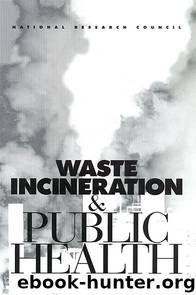WASTE INCINERATION & PUBLIC HEALTH by National Research Council

Author:National Research Council
Language: eng
Format: epub
Tags: Environment and Environmental Studies : Waste Disposal and Clean Up. Health and Medicine : Public Health and Prevention
Publisher: NATIONAL ACADEMY PRESS
Published: 2000-09-21T16:00:00+00:00
THE COMMITTEE’S CONSENSUS JUDGMENTS ABOUT WASTE INCINERATION AND PUBLIC HEALTH
After considering information on incineration operations and emission characteristics (Chapter 3), environmental behavior of pollutants of concern and contributions of incineration to environmental media (Chapter 4), and health-effects information summarized earlier in this chapter, the committee reached consensus judgments on various degrees of concern about incineration and public health on the basis of what is known, and in view of the lack of important information, as described in this report. The lack of such information has contributed to the substantial concern among many communities about possible adverse health effects resulting from incinerators. It is important to note that uncertainty also exists around current estimates of exposures and health effects with respect to other waste management practices.
In developing its consensus judgments about the various degrees of concern, the committee used an approach similar to a preliminary screening assessment intended to err on the side of caution in the face of substantial uncertainty. But in expressing its degrees of concern, the committee is not attempting to judge whether health effects are occurring. That would take a full-scale evaluation and would require much more information than was available to the committee. After additional information is obtained, it is possible that a degree of concern for a particular pollutant might change.
Table 5-8 shows the committee’s qualitative consensus judgments of the relative degrees of concern for potential health consequences generally posed by waste incineration facilities. The following three populations are considered in this table: persons who work at the facilities, persons who live in close proximity to the facilities, and those individuals residing farther away who may be exposed to pollutants from multiple distant incinerator facilities. Each population is expected to experience quite different exposures because of different time-activity patterns, distances from the emission sources, or the chemical-specific nature of the pathways through which they may be exposed.
Download
This site does not store any files on its server. We only index and link to content provided by other sites. Please contact the content providers to delete copyright contents if any and email us, we'll remove relevant links or contents immediately.
| Acoustics | Bridges |
| Earthwork Design | Environmental |
| Fire Science | Highway & Traffic |
| Hydrology | Remote Sensing |
| Seismic Design | Structural |
| Structural Dynamics | Surveying & Photogrammetry |
| Transportation |
Whiskies Galore by Ian Buxton(40295)
Introduction to Aircraft Design (Cambridge Aerospace Series) by John P. Fielding(32330)
Small Unmanned Fixed-wing Aircraft Design by Andrew J. Keane Andras Sobester James P. Scanlan & András Sóbester & James P. Scanlan(32135)
Craft Beer for the Homebrewer by Michael Agnew(17439)
Turbulence by E. J. Noyes(7032)
The Complete Stick Figure Physics Tutorials by Allen Sarah(6631)
Kaplan MCAT General Chemistry Review by Kaplan(6044)
The Thirst by Nesbo Jo(5778)
Bad Blood by John Carreyrou(5761)
Learning SQL by Alan Beaulieu(5399)
Weapons of Math Destruction by Cathy O'Neil(5029)
Man-made Catastrophes and Risk Information Concealment by Dmitry Chernov & Didier Sornette(4728)
iGen by Jean M. Twenge(4693)
Digital Minimalism by Cal Newport;(4511)
Life 3.0: Being Human in the Age of Artificial Intelligence by Tegmark Max(4492)
Audition by Ryu Murakami(4091)
1,001 ASVAB Practice Questions For Dummies by Powers Rod(4034)
Electronic Devices & Circuits by Jacob Millman & Christos C. Halkias(4019)
Pale Blue Dot by Carl Sagan(3995)
